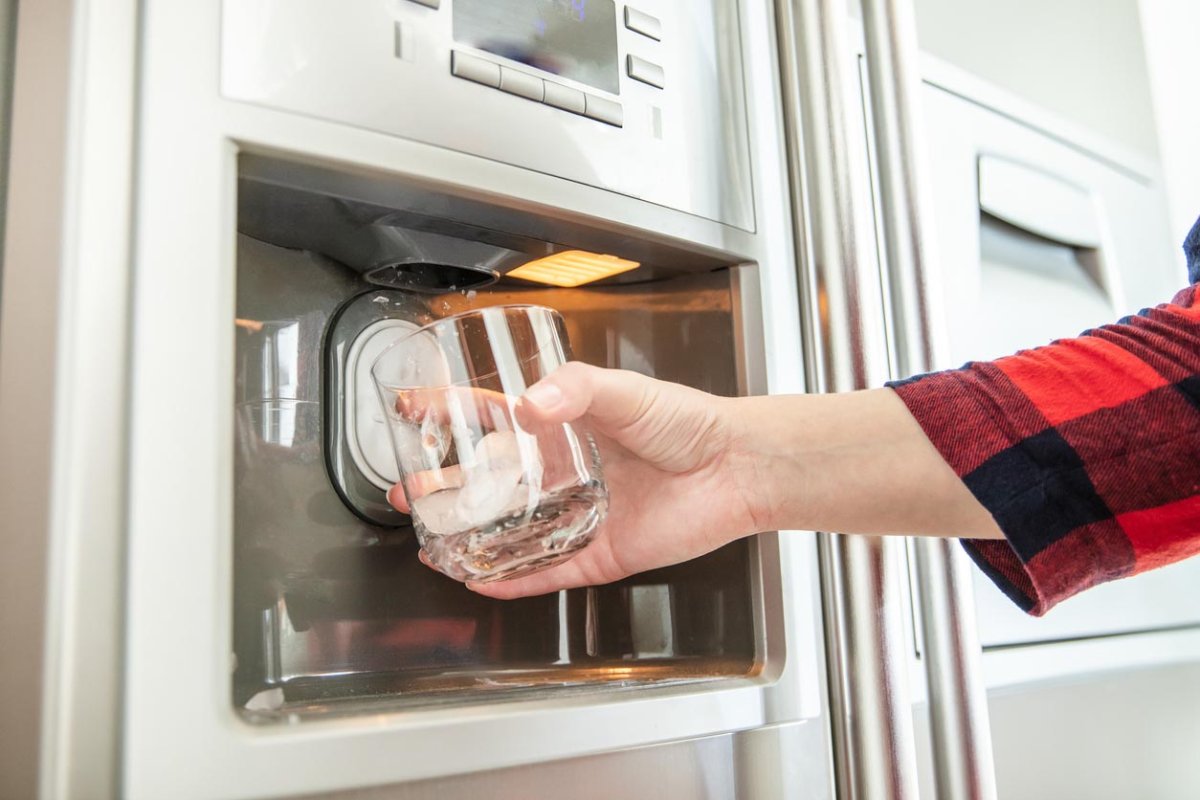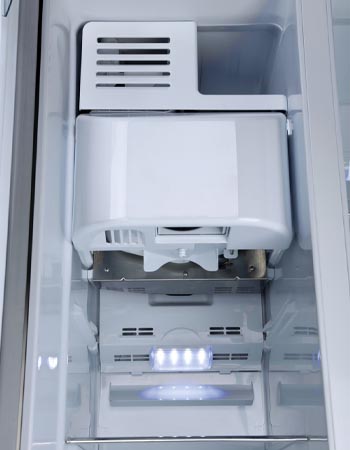

We may earn revenue from the products available on this page and participate in affiliate programs. Learn More ›
Q: My ice maker stopped working and now I can’t get any ice cubes from it. Why is the ice maker not working, and how do I fix it?
A: A broken ice maker can be incredibly frustrating, and it also happens to be one of the most common refrigerator issues. A multitude of factors can lead to an ice maker in the freezer that is not working, so it’s important to understand the potential reasons to be able to fix it quickly. Read this guide to discover the cause of the refrigerator ice maker not working and how to get it up and running again.
If there is ice in the tray, the ice maker might need to be reset.

If ice cubes are forming in the ice tray but they haven’t dropped down into the collection bin, this means the ice maker is receiving water. The presence of ice signals that a mechanical or electrical problem, rather than a water supply problem, is most likely to blame.
The first refrigerator troubleshooting step to take is to check whether the control arm or wire is in the “off” (up) position, which stops the production of ice. (It’s easy to inadvertently bump into this while rummaging in the freezer.) If the control arm or wire is “off,” simply move it to the “on” (down) position. For refrigerators with ice makers controlled by touch panels, toggling the power may also work.
If the ice maker is switched to “on,” the tray is filled with ice, and ice cubes still won’t come out, the ice maker may need to be reset. On many models this process is as simple as unplugging the fridge for 60 seconds, then plugging it back in. On other models, pressing a few buttons in a particular order will automatically reset the ice maker. The process may look different for those who have one of the best undercounter ice makers or best portable ice makers, as these models are not connected to a fridge. It’s a good idea to reference the unit’s user manual for exact instructions. After resetting the ice maker, lift, then lower, the control arm or wire, and wait 10 seconds for the ice tray to refill with water.
If there is no ice in the tray, the ice maker’s water flow may be to blame.
If the ice machine is not working altogether—meaning there’s no ice in the tray—water flow issues may be to blame. According to Jason Carter, appliance technician and founder of Simply Swider, which provides expert tips and advice on appliance maintenance and repair, “If no water’s getting to the ice maker, [it] could be the water supply’s issue … Sometimes, if the ice cubes are coming out smaller than usual, that’s a tell too. [It] means water’s trickling in slowly, maybe [because] of a clogged filter or low pressure.” A clog, leak, or damage in the water line may cause the ice maker to shut off automatically or otherwise stop working.
Carter adds, “If [the water inlet valve is] damaged or has some electrical issue, no water gets through to make ice. I’ve seen plenty of water lines that get frozen solid or get a kink in them— that’ll stop your ice in its tracks.” Check the ice maker inlet valve and water supply tubing for any leaks, damage, or blockages. Some water lines will have a screen in place to catch debris that can become clogged over time. Then, tighten any loose connectors, repair any broken seals or cracks in the water line, and remove anything blocking the water flow. A common culprit of clogs is frozen water in the line; in this case, it’s best to simply shut off the valve and defrost the water line to get everything working again.
While a handy homeowner can often make these repairs and replacements themselves, those who aren’t comfortable or familiar will want to consider reaching out to a local appliance repair service when the ice maker won’t work.
The water filter might be dirty or clogged and need replacing.
Another potential reason behind an ice maker that quit working is a dirty water filter. Smart fridges will often indicate when the filter needs to be changed, but a good rule of thumb is to replace it every 6 months. Telltale signs of a dirty water filter include changes in the smell or taste of the ice and water and a slower flow from the fridge’s water dispenser. In some cases, the refrigerator may even be designed to stop dispensing ice or water when the filter is past its “replace by” date, which could make it seem like the ice machine in the fridge is not working. In other cases, the filter could become so clogged that water can no longer pass through, which is especially common for those with hard water.
Changing a water filter is usually fairly straightforward—homeowners can often simply remove the filter cover, twist out and remove the old filter, and twist in the new filter. It’s recommended to consult any refrigerator-specific instructions to ensure proper filter choice and installation.

The ice dispenser may be blocked.
In some cases, homeowners may observe that the ice maker is not working but the water does seem to be flowing sufficiently. For example, if there is plenty of ice inside the ice maker but it won’t come out when the dispenser is activated, there is likely a large clump blocking the rest of the ice’s path. After ice is dispensed, pieces can get lodged in the dispenser chute and then melt together, creating a cluster of ice. If this is the culprit, it’s an easy ice maker repair—homeowners can simply reach up inside the chute and remove the clump, breaking it up if necessary.
The thermostat may be set too low, causing the water to freeze before it reaches the ice maker
“A lot of times, folks just [have] their freezer set too cold or not cold enough—it messes with the ice making,” says Carter. This is because when the temperature in the freezer is too low, this can cause the water supply line to freeze, which will prevent water from flowing to the ice tray. A freezer that is too warm may not allow the ice cubes to freeze through completely. In this case, the ice maker will sense that the cubes are not frozen and will not complete the rest of the cycle. Homeowners can use a thermometer to check their freezer’s temperature. If a freezer is set at anything higher or lower than 0 degrees Fahrenheit, it can result in the freezer ice maker not working. If the temperature is below zero, the ice maker’s water supply has likely frozen and the freezer will need to thaw out for several hours. The freezer will need to be emptied and the fridge unplugged for at least 8 hours with the freezer door open. It can then be plugged back in and reset to cool to 0 degrees.
The ice maker may be fitted with the incorrect water valve adapter.
If an ice maker’s water valve has been fitted with a valve adapter that is not the right size, this can lead to leaks and low water pressure. Ideally, the water pressure in the ice maker valve will be around 20 pounds per square inch (psi). Low water pressure could result in the ice tray not filling, meaning that little or no new ice is made. The fridge’s user manual may include information on the correct adapter size for a particular model. Otherwise, an appliance repair technician will be able to identify and install the correct part.
The water dosage can be adjusted for cubes that are too big or too small.
In some cases, an ice machine will form cubes that are too small (in the absence of a water line clog) or too big. In this case, a small adjustment to the water dosage can get cubes back to that just-right size.
To change how much water fills the ice cube tray with each cycle, first remove the ice maker cover. Underneath the cover, there’s a plus and minus indicator with a screw and spring assembly. Screwing in, or toward the minus symbol, will decrease the amount of water per cycle; screwing out, or toward the plus, will increase the amount of water per cycle. If all other issues with the ice maker have been resolved, the next batch of cubes will be at the proper size.

Hiring a reputable appliance repair service might be the easiest and fastest way to get an ice maker working again.
When a fridge breaks down, it’s tempting to try DIY repairs to save on time and appliance repair costs. But whether the ice maker in the fridge is not working or there’s frost in the freezer, most kitchen appliance issues are best left to a professional—especially for those who don’t have experience with plumbing, electrical, and other types of repairs. The most reputable appliance repair services will hire qualified, knowledgeable professionals who can quickly and easily take care of any refrigerator ice maker repairs. “Plenty of times, folks can sort out their ice maker issues on their own,” says Carter. “But … when you start seeing trouble with the water supply line, or the electric bits start acting up, that’s when you [need to] call in someone with know-how. From my time tinkering with these machines, I’ve learned if you’re scratching your head after the simple stuff, or if what you tried [didn’t work], don’t risk a bigger mess. Get a pro to take a look.”
When researching the best appliance repair services, it’s wise to make sure the technician is properly licensed and certified as per federal and state laws. A reputable repair technician will also be up to date with a variety of technologies and procedures, as well as offer service warranties for their work. Homeowners who are concerned about the cost of repairs may be interested in a home warranty policy. The best home warranties from providers such as American Home Shield and AFC Home Club can significantly reduce what homeowners pay not only for appliance repair but also for repairs to home systems such as plumbing, electrical, and HVAC.
